Peter Paul, seen here scanning the horizon not far from Be'Er Sheva, had already been here before the CITES meeting, but at night - a much better time to see the considerable variety of reptiles that live in this seemingly-barren landscape.
Some people may think that a desert is devoid of all life. Naturalists know better. It’s just that most of the plants can be rather scraggly, unimpressive things (the Negev lacks the giant cacti of the New World or the tree-sized Euphorbias of the old) and much of the animal life stays out of sight in the heat of the day. All that means, of course, is that to see it, we naturalists have to look harder.
One of the more obvious desert plants is the Colocynth or Bitter Cucumber (Citrullus colocynthis). Its stems sprawl over the desert floor, sprouting melon-sized fruits as they go. The fruits contain a highly irritating toxin, cucurbitin. Colocynth has long been used as a laxative or other intestinal cure-all (and as such has gained literary mentions in everything from Shakespeare’s Othello to Gilbert and Sullivan’s Patience) despite the fact that its side effects can include convulsions, paralysis and death.
As I have often remarked, I am no botanist. I have no idea what these plants are. Nonetheless, I do know that desert plants will go to great lengths to avoid losing water. Notice the tiny, thick, waxy leaves clinging to the stems of the plant in the lower two photos, adapted to retain every drop they can get.
I don’t know what this is either, but it seems to be an example of another desert strategy: wait for the rains, send up a stalk of flowers, and get your pollinated seeds out there before the place dries up again. Whatever this was, I imagine it looked quite lovely in life - a natural nosegay, perhaps. It certainly looks strange enough now.
Snails in the desert? I was astonished to find these shells, and at first wondered if a passing bird had dropped them. Shows what I know. Meet Sphincterochila boissieri, an air-breathing (or pulmonate) snail, and a genuine desert-dweller that can tolerate temperatures up to 50°C. Its white shell is no accident; it can reflect away up to 90% of ambient light, a useful adaptation in an environment blazing with sunshine. Most of its life is spent in a dormant state. It only springs to life after rains, and then only for about ten days or so. After that, it withdraws deep in its shell and waits, perhaps months, for the rain to fall again.
There may not be much animal life to see here by day, but the signs of it are everywhere. Trails of footprints crisscross the sands - lizards, mostly? A beetle or two?
Some of the footprints may have belonged to the Nidua Fringe-fingered Lizard (Acanthodactylus scutellatus), one of a group of little desert lizards common in the Middle East. The fringe on their toes - actually modified scales - keep them from sinking into the loose sand. This species ranges across North Africa to the Arabian Peninsula. Deserts are harsh places even for this little creature: it can survive here, true, but it only lives for a year.
A dragonfly in the desert may seem even more out of place than a snail. Certainly I did not expect to see one, but these Red-veined Darters (Sympetrum fonscolombii) seemed to be quite common. Unlike the snails, though, they were probably just passing through. This is one of the most peripatetic of dragonflies, a wanderer and migrant that has strayed as far north as Scotland and Sweden - something that has been known since at least 1840. It’s alternate English name, in fact, is Nomad.
Our next stop was a patch of sand dunes in the northwestern corner of the Negev, not far from the Egyptian border. It was home to a population of Hermann’s Tortoises (Testudo hermanni). There was no chance of seeing them by day, alas, but we set off nonetheless to see what else we could turn up.
It was, tortoises or no, a bleakly beautiful place.
Here was more desert plant life, stark, largely dry and, for me, unidentifiable.
Walking over the dunes was hot and difficult as the sands shifted under our feet, but it was worth it for the views.
I tried, as we went, to get a feel of the ecology of the place. Do the root systems of the dune grasses hold the grains of sand together, as similar plants do to stabilize the dunes of New England’s coast?
Besides the obvious tiny leaves, how do other dune plants keep from losing water? Even on the rare occasions when it rains, the water must drain rapidly past their roots.
What are the spikes on these plants guarding against? Probably gazelles, though we didn’t see any (Israel has an excellent conservation record, but even so there must be fewer than there used to be).
What left these footprints in the sand? Yours truly excepted, of course.
The hottest spot in any desert will normally be the surface of the sand and the boundary layer of air directly above it. For an ant, the best way to avoid it may be to simply have longer legs than usual. Is that why this particular ant looks like it is on stilts? I don’t know - but apparently leg length does corellate with heat in some Negev darkling beetles (Tenebrionidae), suggesting that ‘stilting’ may be a real thing.
This little fellow, which I believe is a Long Fringe-fingered Lizard (Acanthodactylus longipes), may be doing the same thing - or may simply be displaying, or trying to get a better view of his surroundings.
Hopping up on a handy bit of dried wood had much the same effect, whatever that effect is.
According to Sherif Baha el Din's A Guide to the Reptiles and Amphibians of Egypt (just over the border, after all), this is "the commonest lizard to be found in dune and undulating sand habitats" where it is the dominant reptile species (whereas A. scutellatus, shown above, is also found on more compacted and stony desert soils (similar, in fact, to those at our first stopping point). Both lizards occur broadly across North Africa.
Lizards aside, insects are the most obvious creatures in the desert (at least by day). Israel has a long list of Robber Flies (family Asiliidae) - 182 recorded species - and I won't even begin to guess which one this is. They do particularly well in warm, sandy deserts, where they are known to control their body temperatures - a valuable adaptation, given the extremes of heat and cold in desert habitats. They manage this both behaviourally - by perching at different heights from the ground, or orienting their bodies to face towards or away from the sun - and by controlling the amount of haemolymph (the insect version of blood) that they pump into their abdomens.
This little moth (Erebidae: Arctiinae) is a Crimson Speckled Footman (Utetheisa pulchella). It is apparently a dune specialist, whether in the desert or along the coast (and of course in Israel it could be both at the same time). Rare in Europe (a victim of coastal overdevelopment), it is still common in Africa and Asia.
According to Sherif Baha el Din's A Guide to the Reptiles and Amphibians of Egypt (just over the border, after all), this is "the commonest lizard to be found in dune and undulating sand habitats" where it is the dominant reptile species (whereas A. scutellatus, shown above, is also found on more compacted and stony desert soils (similar, in fact, to those at our first stopping point). Both lizards occur broadly across North Africa.
Lizards aside, insects are the most obvious creatures in the desert (at least by day). Israel has a long list of Robber Flies (family Asiliidae) - 182 recorded species - and I won't even begin to guess which one this is. They do particularly well in warm, sandy deserts, where they are known to control their body temperatures - a valuable adaptation, given the extremes of heat and cold in desert habitats. They manage this both behaviourally - by perching at different heights from the ground, or orienting their bodies to face towards or away from the sun - and by controlling the amount of haemolymph (the insect version of blood) that they pump into their abdomens.
This little moth (Erebidae: Arctiinae) is a Crimson Speckled Footman (Utetheisa pulchella). It is apparently a dune specialist, whether in the desert or along the coast (and of course in Israel it could be both at the same time). Rare in Europe (a victim of coastal overdevelopment), it is still common in Africa and Asia.




































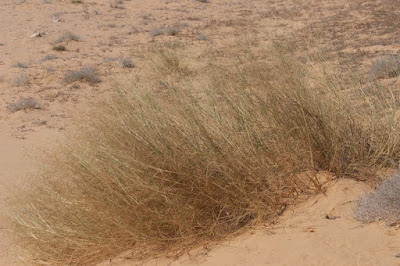










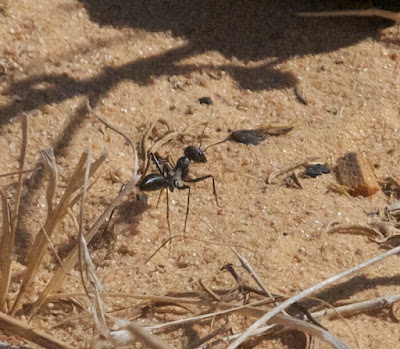

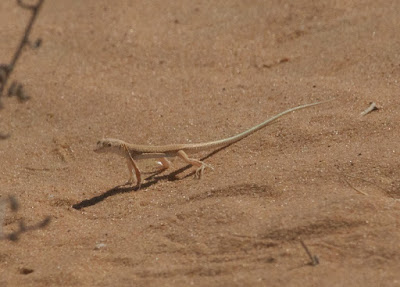


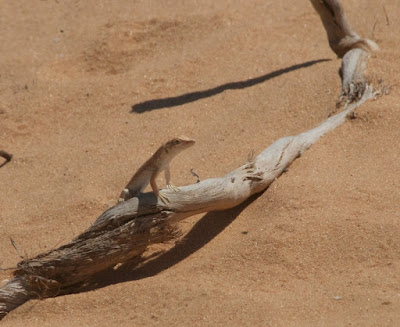




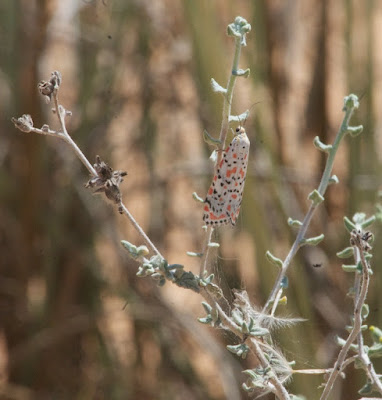



No comments:
Post a Comment